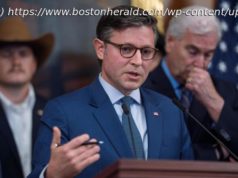President Trump falsely claimed that his administration is “bringing back to America” manufacturing jobs “by the hundreds of thousands.”
At a rally in West Virginia, President Trump falsely claimed that his administration is “bringing back to America” manufacturing jobs “by the hundreds of thousands.” In fact, about 70,000 manufacturing jobs have been added since he took office, federal labor statistics show.
The president also puffed up his record on creating jobs in general, and coal-mining jobs specifically. He also repeated misleading talking points on the nation’s gross domestic product, immigration, war spending and Hillary Clinton.
Trump’s latest campaign-style speech to supporters was on Aug. 3 in Huntington, W. Va. The president, who campaigned on a promise to be “ the greatest jobs president that God ever created, ” focused a good part of his speech on jobs and the economy.
As we wrote at the time he took office, Trump inherited an economy that was experiencing steady job growth. We said that the unemployment rate was 4.7% and the economy had gained jobs for 75 straight months – the longest streak on record. That streak has continued and the unemployment rate has now dropped to 4.3% .
Trump, however, goes too far in some cases when claiming credit for the continued economic growth.
In criticizing the Democrats for focusing on the federal investigation into Russia’s meddling in the 2016 presidential election, Trump made a false boast about manufacturing job growth.
First, the Russia story, of course, is not totally made-up. The U. S. intelligence community has determined that Russian President Vladimir Putin “ordered an influence campaign in 2016, ” including cyberattacks on the Democratic National Committee, to help Trump win the election. The Department of Justice and Republican-controlled congressional committees are investigating whether there was any coordination between Russia and the Trump campaign. (See “ Timeline of Russia Investigation ” for more information.)
And what about those manufacturing jobs? Trump is wrong. The U. S. has not added “hundreds of thousands” of manufacturing jobs since Trump became president. The actual figure is 70,000, according to the Bureau of Labor Statistics. The U. S. had 12,355,000 manufacturing jobs in January, when Trump took office, and 12,425,000 as of July.
Trump also said, “Since our election — not mine — since our election, we’ ve added more than one million new jobs.” This has been a talking point for Trump, but it lacks context.
First, Trump has been taking credit for jobs that were added to the economy while Barack Obama was president, as he did at a rally last month in Ohio. We measure jobs growth under Trump from the time he took office in January. By that measure, the economy has added nearly 1.1 million jobs from January through July, according to the BLS.
But let’s put that 1.1 million figure into context. During that same period a year ago, the U. S. economy added more than 1.2 million jobs — so the nation continues to add jobs under Trump, although at a tad slower pace.
As we’ ve written, the U. S. economy has been adding jobs every month since October 2010 — a record-setting 82 straight months, as of July.
Trump also boasted that his administration is “putting our coal miners back to work.” That’s a bit of an exaggeration.
The number of coal mining jobs has increased by a net of 600 jobs between January and July, going from 50,000 to 50,600, according to the BLS. The most recent jobs report, which was released Aug. 4, shows a drop of 200 jobs between June and July.
Trump noted that “American exports of coal are already up more than 60% this year.” That’s backed up by a Reuters analysis of government data on coal exports. Reuters attributed the jump to “soaring demand from Europe and Asia” fueled in part by a demand for coal in France after a series of nuclear power plant outages. In 2016, about 8% of U. S. coal production was exported to other countries, according to the U. S. Energy Information Administration.
In a July 18 report, the EIA stated that while coal exports for the first quarter of 2017 were 58% higher than in the same quarter last year, “EIA expects growth in coal exports to slow in the coming months.” The report also said, “With coal exports running well below export capacity, no significant expansions of coal export facilities in the United States are currently under construction.”
The president also repeated some of the same false and misleading claims that we have covered before.
Trump on GDP: “Economic growth has surged to 2.6% nationwide. You have to understand what that means. Nobody thought that number was going to happen.”
As we have written before, the 2.6% growth in real GDP for the second quarter was not that unusual nor unexpected.
Real GDP was higher than 2.6% in eight of the last 18 quarters, according to data from the Bureau of Economic Analysis. Although Trump said “nobody thought that number was going to happen, ” some economic models actually forecast higher growth. The Federal Reserve Bank of Atlanta, for example, initially forecast in May that the second quarter GDP growth would be 4.3%. Economists also caution to not read too much into any one quarter’s performance, as the numbers tend to go up and down through the year, and are often revised based on newer data.
Trump on RAISE Act: “Our proposal prevents new immigrants from going on welfare for at least five years. So you don’ t come in and go on welfare.”
Trump is referring to the Reforming American Immigration for a Strong Economy (RAISE) Act, and mischaracterizes the impact of the proposed legislation on the ability of newly arriving immigrants to receive public benefits.
The bill — which was proposed by Republican Sens. Tom Cotton and David Perdue, and endorsed by Trump — seeks to halve legal immigration into the U. S. by reducing the number who gain entry based on family ties and emphasizing a “merit-based” immigration system. But as we wrote when Trump discussed the bill at a press conference earlier this week, current federal law already bars most new immigrants from most federal public assistance programs for five years. There are exceptions in the current law, such as for children and pregnant women. The RAISE Act would expand the prohibition on some public assistance to the households of some new immigrants, but many who qualify for public assistance under the current law would remain eligible under the proposed bill.
Trump on war spending: “Think of it. We’ ve spent $6 trillion in the Middle East, and the Middle East is 100 times worse than it was 16 years ago when we started. Can you believe this? What a shame.”
Actually, the U. S. spent over $1.7 trillion on “war-related activities” from 2001 through Sept. 30,2016, according to a February 2017 report from the Congressional Research Service. During the campaign, Trump cited a $6 trillion estimate for the long-term cost of the war. Boston University political science professor Neta Crawford put that figure at between $4.8 trillion and $7.9 trillion when including future costs for such things as veterans’ medical and disability costs, debt service on borrowed money, and war-related spending in the Department of Homeland Security.
But Trump repeatedly and wrongly uses the past tense — “spent” — to describe the spending.






